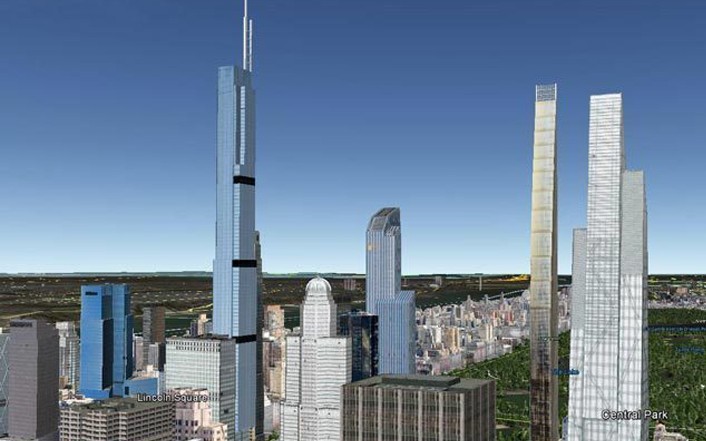SEPTEMBER 2014 • It’s clear that 57th Street is where it’s at for really tall and skinny new buildings that are reshaping the Manhattan skyline. One57 and 432 Park Avenue are the most visible examples so far, SHoP’s 111 West 57th and Extell’s Nordstrom tower will follow, and they are all within four blocks. Part of the trend along this specific corridor has to do with floor area ratio (FAR), the formula that equates to maximum developable floor space allowed at a property. FAR can be stretched really tall with a few tricks and trades, and it underlines the debate over how liberal or restrictive the city should be with height limits and the air rights market. Just how easy it was for developers to stretch FAR on 57th Street is made clear in a 2010 report by architecture students at Columbia University’s graduate school.
Before we dive into the study, a brief explainer on FAR, from the report:
FAR is the ratio of the building’s floor area to the area of its zoning lot. Each zoning district is given a maximum allowable FAR that when multiplied by the lot area produces the maximum amount of floor area allowed. For example, on a 10,000-square-foot zoning lot with a maximum FAR of 1.0, the maximum square footage of the entire building can only be 10,000 square feet. This 10,000 square feet can be molded different ways – one could use the whole zoning lot and construct a 1 story building, use half the site and construct a 2 story building, or use a quarter of the site and construct a 4 story building, all of which would add up to the maximum 10,000 square feet, dictated by the lot size and FAR.
The report, conducted by students in a 2010 architecture class at Columbia University, profiles Midtown North from 53rd Street to 59th Street between Broadway and Fifth Avenue, leaving 432 Park just outside of the study area. The students, setting out to make recommendations for preservation, considered as a variable the unused floor space allowed for each lot. In a set of graphics, 57th Street comes out looking like a FAR mecca. One graphic shows that the streets in the study area had different combinations of 8, 10, 12, and 15 FAR, but 57th Street was the only street with all 15 FAR and in stark contrast to 58th and 59th Streets that have mostly only 10 FAR.
The report also shows that compared to other streets in the study area, the percentage of actual used FAR on 57th Street was very low. Many of the lots in the whole study area also have low percentages of used FAR with some exceptions, such as most of 53rd Street between Sixth and Seventh avenues.
Another graphic shows two examples of how the FAR could be used pre-One57 (in 2010, One57 was just starting to be built). The first example shows how the FAR could be built as-of-right, while the second shows how the FAR could be stretched vertically with skinny buildings. In the second example, a building that looks like it could be the
Nordstrom Tower, stands at about 900 feet. The Nordstrom tower itself will be 1,490 feet at its roof and 1,775 at spire height.
Since 57th Street has the highest amount of FAR and the least used FAR, it’s the ideal location for developers to combine tax lots to allow for sites with zoning that allows bigger buildings. And when air rights are thrown into the mix, buildings can grow even larger. The area has a number of landmarks and lower-rise buildings that have unused air rights that can be sold and transferred to neighboring lots (example: Extell buying up rights from the Art Students League for the Nordstrom Tower). Katherine Malishewsky, a restoration architect at Kamen Tall Architects and one of the former students who compiled the report, says that landmarking in the area plays an interesting role. The selling of unused air rights allows for larger buildings nearby, but it also keeps landmarks as they are since they rid themselves of their additional FAR. “Even though nobody likes really tall buildings blocking their views, all the buildings next to it are going to stay low,” she said. “It’s a developer’s tool, but it could be a tool for preservation as well.”
The students recommended 35 buildings to be landmarked, including the Solow Building on 57th Street, MoMA at 11 and 9 West 53rd Street, and Tiffany’s & Co on Fifth Avenue. They also recommended that West 57th Street and Fifth Avenue be designated a historic district.
Malishewski said she isn’t surprised to see that the study area is now being developed with super-scrapers. “It wasn’t a shock. That’s what that area is known for. Historically, in the 1800s, they hired the most innovative architects.” She said that though now the buildings are very skinny, “it’s in the same spirit as it always has been.”
The students, led by advisor Kate Wood, were Ashley Albahary, Katherine Malishewsky, Sarah Modiano, Lauren Racusin, Sarah Sher, and Amy Swift.




